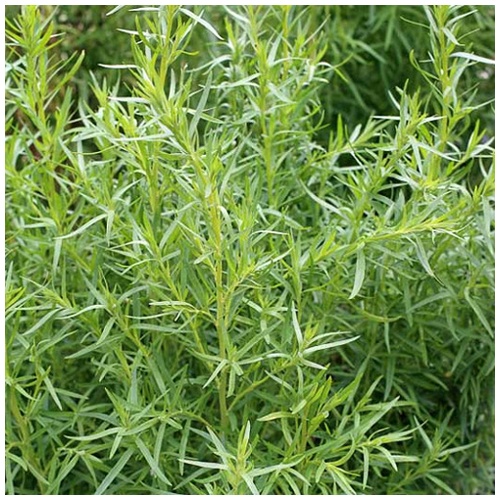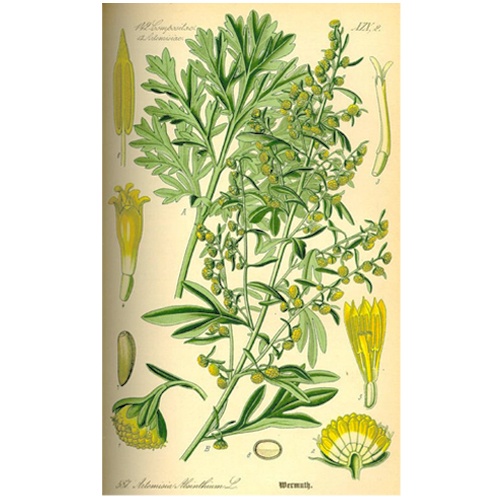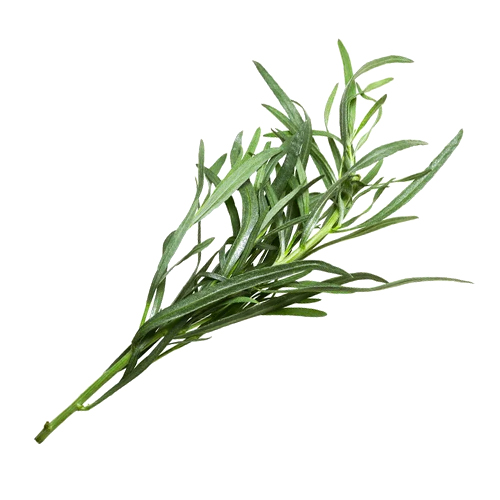
|
|
CULTURAL AND WILD PLANTS
Wormwood tarragon (tarragon, tarragon). Legends, myths, symbolism, description, cultivation, methods of application
Directory / Cultivated and wild plants Content
Tarragon wormwood (tarragon, tarragon), Artemisia dracunculus. Photos of the plant, basic scientific information, legends, myths, symbolism
Basic scientific information, legends, myths, symbolism Sort by: Artemisia Family: Asteraceae (Asteraceae) Origin: The homeland of the plant is not exactly known, but presumably it is Mongolia, the Caucasus, South Siberia. Area: Wormwood tarragon is common in Europe, Asia, North America and Africa. Chemical composition: The main active substances of the plant are estrogol, estragole, myrcine, sabinene, camphor, etc. Economic value: Wormwood tarragon is used as a spice in cooking, also has medicinal properties, including pain relief, relieves spasms, improves appetite, etc. Legends, myths, symbolism: In Slavic culture, tarragon tarragon is credited with protective properties against evil spirits and diseases, and it is often used in ritual rites and spells. In cooking, tarragon is widely used in many dishes. It is also used in the production of liqueurs, such as the famous Absinthe drink. In folk medicine, tarragon is used as a tonic and sedative, as well as a cure for digestive disorders and diseases. In various religious cultures, tarragon also has a symbolic meaning. For example, in Christianity it is associated with Easter and is used in the Palm Sunday procession. In ancient Greek mythology, wormwood is associated with the goddess Aphrodite, who, according to legend, scattered it on the ground as a symbol of her love.
Tarragon wormwood (tarragon, tarragon), Artemisia dracunculus. Description, illustrations of the plant Tarragon wormwood (tarragon), Artemisia dracunculus L. Botanical description, distribution, chemical composition, features of use
Aster family - Asteraceae. Perennial. The rhizome is woody. Stems few, 40-150 cm high, erect, glabrous, yellowish-brown. Stem leaves entire, oblong or linear-lanceolate, pointed; the lower leaves are notched at the top. Flowers are pale yellowish. Inflorescence paniculate, narrow, dense; involucral leaflets shortly elliptical or almost spherical; involucre glabrous, greenish-yellowish, shiny, membranous along margin. The fruit is an oblong achene, without a tuft. Blooms in August - September. The fruits ripen in October. It occurs wild in Eastern Europe, Central Asia, Mongolia, China, Pakistan and India; in North America grows from Central Mexico to the subarctic regions of Canada and Alaska. The aerial part contains carotene, alkaloids, essential oil, flavonoids, ascorbic acid, coumarins; in the roots - traces of alkaloids. The content of essential oil in the green mass reaches 0,1-0,4% on a wet weight or 0,25-0,8% on an absolutely dry weight. Sabinene (up to 65%), myrcene (10), sesquiterpene fraction (5), p-metaoxycinnamic aldehyde (0,5) and resin (15%), methylchavicol, ocimene, and phellandrene were found in the essential oil.
Wormwood tarragon has a slightly spicy aroma and a sharp, spicy and spicy tart taste. Known varieties of salad directions, common in the Caucasus and Central Asia, and spicy-aromatic forms (Ukraine, Moldova). The green mass of the plant is widely used in fresh cooking as a spicy-aromatic seasoning for pickling cucumbers, tomatoes, making marinades, sauerkraut, soaking apples, pears. The essential oil is used to flavor vinegar, as well as in the canning and food concentrate industries. Especially popular in France is the production of a special aromatic-spicy vinegar from the aerial part of tarragon wormwood, which is used to season salted fish. The green mass of the plant is used as a spice in the preparation of dishes from rice, boiled fish, mayonnaise, fried game, lamb. It improves the taste of pork belly and smoked meats. Its taste is more pronounced if the dish is lightly sprinkled with lemon juice. Finely chopped fresh leaves are added as a spice to poultry, eggs, light sauces, meat dishes, as well as to all types of salads. They can be used to make green butter. Wormwood tarragon in the composition of culinary products enhances the formation of gastric juice, improves appetite, normalizes the functions of the endocrine glands, in particular the sex glands. Currently, the plant attracts the attention of researchers as a carotene-containing plant. A refreshing drink "Tarhun" is prepared from it. Often used to flavor wines and liquors.
In Germany, in the past, meat and game were rubbed with fresh tarragon to prevent flies from landing on them. In folk medicine, the aerial part of the plant is used as an antihelminthic, for edema and scurvy. Tarragon tarragon was used in cosmetics for neck skin care. The plant has a fodder value, in hay and silage it is well eaten by cattle. Authors: Dudchenko L.G., Kozyakov A.S., Krivenko V.V.
Tarragon, Artemisia Dracunculus L. Classification, synonyms, botanical description, nutritional value, cultivation
Names: az. terhune; arm. tarragon; cargo, tarragon; German Esdragon, Dragun, Bertram, Kaiserkraut; Goal. dragoncruid; dates estragon, kaisersalat; Swede, dragon; English tarragon; fr. estragon, torgon, serpentine; it. dragone, dragoncello, targone; Spanish estragon; port, estragao; hung. tarkony; Slovenian pehtran, kozlac; Serb, torkanj, trkos; Polish estragon, draganek. A perennial plant from the genus Artemisia comes from Mongolia and Southern Siberia. Cultivated forms differ from wild ones in a strong smell. Stem herbaceous, 60-125 cm tall; leaves lanceolate; rounded flower baskets; petals are white. There are two races of tarragon: German (the name "French tarragon" is found in the literature, apparently, this is a synonym for German tarragon) dark green and Russian dull green. The first race reproduces exclusively vegetatively. In forms of tarragon that reproduce by seeds (Siberian tarragon), the seeds are dark brown, 1-1,5 mm long and wide, 0,25-0,5 mm thick. Weight of 1000 seeds - 0,2-0,3 g; remain viable for 2-3 years.
Any garden soil is good for tarragon. Its seed or vegetative seedlings are planted in open ground at a distance of about 25 cm. In the south, tarragon overwinters well in the ground, while in northern conditions it must be covered with humus. In one place, a tarragon plantation can be 10-15 years old. The fragrant tarragon leaves are used in salads and as spices or condiments for various dishes. Author: Ipatiev A.N.
Tarragon wormwood (tarragon, tarragon), Artemisia dracunculus. Recipes for use in traditional medicine and cosmetology
Ethnoscience:
Cosmetology:
Attention! Before use, consult with a specialist!
Tarragon wormwood (tarragon, tarragon), Artemisia dracunculus. Tips for growing, harvesting and storing
Tarragon (Artemisia dracunculus), also known as tarragon, tarragon or dragonet, is a herbaceous plant that is widely used in cooking. Tips for growing, harvesting and storing tarragon tarragon: Cultivation:
Workpiece:
Storage:
Tarragon can be used as a seasoning for many dishes such as meat dishes, fish dishes, omelettes, soups and salads. Note that tarragon can be toxic in large amounts, so it should be consumed in moderation.
▪ Cayenne pepper (chili pepper) ▪ Ryzhik ▪ Play the game "Guess the plant from the picture"
Energy from space for Starship
08.05.2024 New method for creating powerful batteries
08.05.2024 Alcohol content of warm beer
07.05.2024
▪ Benefits of children's music lessons ▪ Lenovo IdeaPad Duet 3i Tablet ▪ Pressure sensor Infineon DPS422
▪ site section And then an inventor (TRIZ) appeared. Article selection ▪ article Art starts with a little bit. Popular expression ▪ article Which athletes initially began to wear polo shirts? Detailed answer ▪ article Determination of distances by the shadow of an object. Travel Tips ▪ article Medical soaps. Simple recipes and tips
Home page | Library | Articles | Website map | Site Reviews www.diagram.com.ua |






 Arabic
Arabic Bengali
Bengali Chinese
Chinese English
English French
French German
German Hebrew
Hebrew Hindi
Hindi Italian
Italian Japanese
Japanese Korean
Korean Malay
Malay Polish
Polish Portuguese
Portuguese Spanish
Spanish Turkish
Turkish Ukrainian
Ukrainian Vietnamese
Vietnamese








 See other articles Section
See other articles Section 